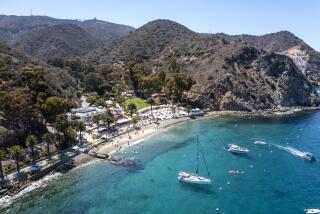Choice Summer Playgrounds in the Caribbean Are Bargain Getaways for Those in the Know
- Share via
When North America swelters in summer heat, the even-sunnier Caribbean must be unbearable, right?
Happily, a lot of people think so, which is one of the reasons that most Caribbean resorts cut their rates by as much as half in the off-season to lure the discriminating minority who know better.
Their favored summer target is the eastern Caribbean--the long string of islands known as the Windwards and Leewards, or Lesser Antilles--that arc north-northwest from the coast of Venezuela to the British and U.S. Virgins.
Temperatures vary little year-around. Average daily temperatures seldom vary as much as 10 degrees above wintertime highs. And the same gentle tradewinds that bathe the islands in winter comfort also take the sizzle out of summer.
While many of the more famous island playgrounds such as Barbados, St. Barthelemy, Guadaloupe and Martinique continue to draw crowds in summer, others that offer as much or more to the off-season visitor are wide open from mid-April to mid-December at prices that make staying at home seem an expensive folly.
Three of my favorites:
GRENADA
To many visitors, this volcanic mountaintop thrusting out of the sea is the most beautiful of all Caribbean islands, a 120-square-mile miniature Hawaii with lush rainforests, crater lakes, waterfalls and what pass in this part of the world for towering peaks almost 3,000 feet above sea level.
Thanks to the Cuban architects and engineers whom a combined United States “rescue” force sent packing in 1983, the now fiercely democratic and pro-U.S. island boasts the newest and best international airport in the region. But the glitzy overdevelopment that often follows in the wake of wide-body jetliners still hasn’t happened, so for the time being, at least, Grenada remains pretty much as it was before the ill-fated Communist government took power and killed tourism in 1979.
The ambience of the capital city, St. George’s, remains decidedly British West Indian, a cascade of pastel buildings and red roofs flowing down the surrounding hills to the carenage, a curving boulevard-promenade that fronts the country’s principle harbor. The prevailing odor here, and throughout the flowery, forested island is nutmeg, Grenada’s major export, for which it shares a virtual world monopoly with Indonesia. Rich with allspice, cinnamon and half-a-dozen other condiments as well, the island is a virtual spice bazaar.
Unlike the more developed islands, Grenada still has relatively few tourist hotels--a little more than 1,000 rooms all told--but unless you like crowds this can be a blessing. Most of the best are on Grand Anse, a powder-white, two-mile beach that ranks with the world’s finest. And summer room rates are 35% to 50% lower than high season.
For those who tire of sun and sand there are a number of professional dive operators who run scuba and snorkel trips to spectacular nearby reefs, as well as deep sea fishing and sailing charters. Some of the hotels have tennis courts and the island boasts one modest but interesting 9-hole golf course near the Grand Anse beach.
As the Marines discovered in 1983, getting to Grenada used to be hard, roundabout work because there were no direct flights from the U.S. Last month American Airlines became the first major airline to operate daily direct service via San Juan, Puerto Rico, from its U.S.cities, including Los Angeles. BWIA also runs daily flights direct from the U.S. with alternate stops in Antigua and St. Lucia.
ANTIGUA and BARBUDA
Although the two-island nation’s sordid political affairs often make world headlines, visitors remain unaffected because even the warring politicians recognize that their life blood flows with tourism which provides more than three-quarters of gross national product. But while far better developed for visitors than Grenada, Antigua’s flawless emerald waters, uncrowded beaches and volcanic hills have produced a similar calypso culture and a welcoming atmosphere that seems to banish unhappiness even among the politically sensitive.
Like most of its neighbors, Antigua shrugged off colonial rule but wisely held on to some of its better remnants, namely English Harbor on the south side of the 108 square-mile island. It was here that Admiral Lord Horatio Nelson, while still a striving young officer, commanded the Leewards Islands Squadron when it was still a tossup whether the Caribbean would become a British, French or Spanish lake.
It became none of the above, but Nelson and others left a substantial 1784 ruin called Nelson’s Dockyard that has been restored like a small-scale Williamsburg. The English Harbor restoration includes one of the more elegant hotels on Antigua, the all suites Copper & Lumber Store, after the original 18th century building of that name, where summertime rates are 45% to 60% lower than winter. There are 12 apartments, five of which face the harbor and they are all differently furnished in an 18th-Century ambience but with all the modern conveniences. There is a restaurant nearby, but a car is necessary to reach other dining spots, beaches and tourist lures.
There is great variety in places to stay, with dozens of large and small hotels and guest houses located directly on Antigua’s much-touted 365 pure sand beaches. Naturally, the emphasis is on water sports, particularly sailing, scuba diving, snorkeling and fishing.
In sharp contrast and only 26 miles away by twice-daily shuttle flights, Antigua’s sister island of Barbuda, which is reached in about 20 minutes via LIAT (Antigua-based Leeward Islands Air Transport). The island still exists virtually unspoiled by the developers, with only about 100 hotel rooms and 1,000 residents at last count.
But the beaches, if you get there, are so untouched that some visitors think they can still make out the lone footprints of Robinson Crusoe’s man Friday.
TURKS & CAICOS
The 8,000-odd residents of these low-lying sand and coral islands, still a British dependent territory, think of themselves as eastern Caribbeaners, even though they are far removed at the foot of the Bahamas in the Atlantic ocean.
But they qualify on my list of favorites because they bathe comfortably in the same balmy tradewinds that keep the comfort level high on islands far to the south of them. They also offer some of the best scuba diving in the western hemisphere.
Like Grenada, the Turks & Caicos have long been overlooked by tropical travelers and as a result tourism development has been slow to take off, a boon to those who like getting in before the crowds.
Of the eight major islands and dozens of smaller cays, only four--Grand Turk, South Caicos, North Caicos and Providenciales (commonly called Provo)--are significantly populated. The widely separated islands are connected by twice-daily shuttle flights, but it is probably better to settle down on just one of them, and the best accommodations, restaurants and services for the visitor can be found on Provo, which, like the others, is a paradise for scuba divers and snorkelers with its 10-mile reef.
The new 100-room Ramada Inn is on a spectacular beach and has all the amenities, including a disco. Smaller resorts of 20 and 25 rooms include Turtle Cove located on the harbor, with swimming pool, tennis court and good restaurant, and Erebus, on a hill overlooking the ocean, with pool and restaurant. The latter has an old and new section and many guests prefer the older, cliff-hanging accommodations. The Ocean Club offers efficiencies and one-bedroom apartments on the ocean; food may be purchased from local stores. There is also a Club Med on the island.
One of the prime diving locations in the world is just a few miles away, off uninhabited West Caicos island, but it isn’t for novices. Just offshore a spectacular great wall teeming with undersea life drops off into the depths, but it begins deep and its beauty can lure the careless diver into danger.
A number of professional dive operators on Provo arrange excursions to this and the many living coral reefs around the islands. And in league with hotels such as the new, luxury Ramada Turquoise some of them offer all-inclusive summertime hotel and diving package deals that cover everything for as little as $100 a day per person.
While Turks and Caicos islands were hard to reach in years past, they now enjoy regular service by Pan American, non-stop from Miami to Provo and Grand Turk.
More to Read
Sign up for The Wild
We’ll help you find the best places to hike, bike and run, as well as the perfect silent spots for meditation and yoga.
You may occasionally receive promotional content from the Los Angeles Times.






